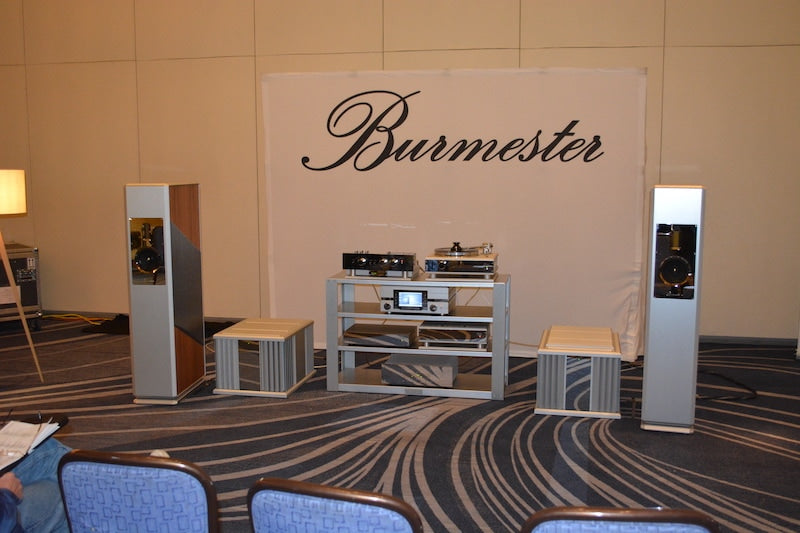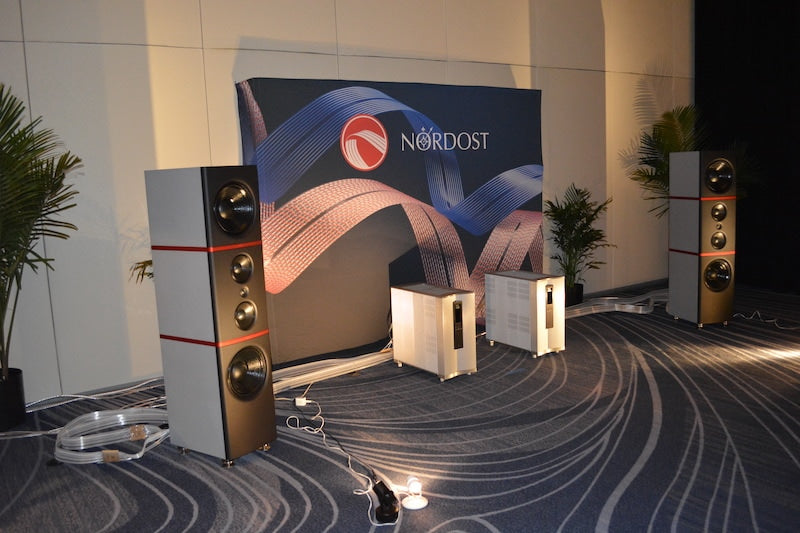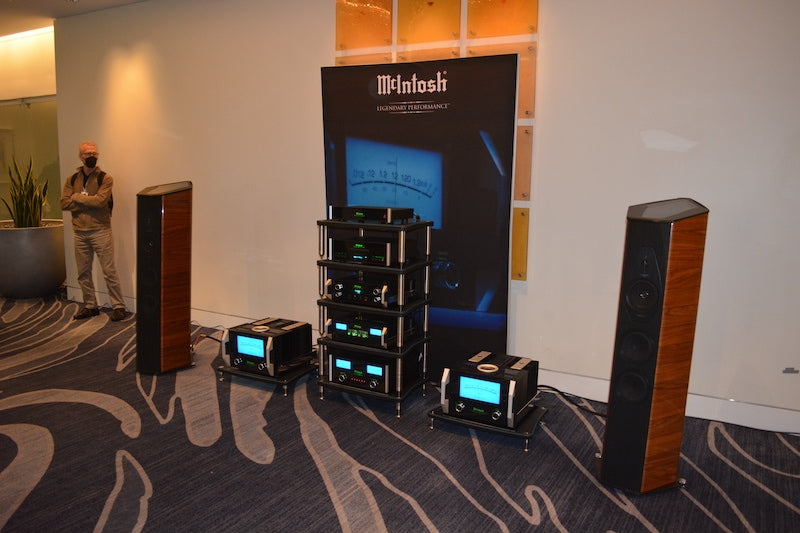One man. More than 150 rooms and 200 exhibitors. 25 seminars. 22 hours. AXPONA 2022.
There’s a reason why audio-show coverage is almost always incomplete: no one person can cover it all. The math: if you wanted to see every room and were there all three days like I was, you’d have less than 8-1/2 minutes per room, if you didn’t eat or go to the bathroom or attend any seminars.
I admit I wasn’t exactly blazing through the show the first day. Most of us in the industry hadn’t seen each other in more than two years, so there were a lot of hellos, handshakes and hugs, a lot of catching up to do. Also, apprehension, given that the show was attended by more than 7,500 people and the specter of COVID hung in the air. (In a crowded elevator, one rather thoughtless individual yelled out, “well, if COVID is here, we’re all going to get it!” Really, dude?) It was a calculated risk for attendees, but nevertheless, a celebration, a reunion, a revival. It reminded us of what being in this crazy business is really all about – of course, the gear, but more importantly, the people who make our not-so-little audio world happen.
There was a Big Announcement: Andrew Jones, formerly of ELAC, Pioneer, KEF and others, has been named the Chief Loudspeaker Designer at Mobile Fidelity Electronics, companion company to audiophile label Mobile Fidelity Sound Lab. Jones is one of the world’s most talented loudspeaker creators, so, expect some very interesting speakers from MoFi in the future.
The mandatory caveats: I never make definitive judgments about sound at shows. There are too many variables, like unfamiliar rooms, unknown AC power, and lack of system/component break-in time, although I was more than a little shocked at the number of exhibitors who hadn’t even begun to set up their rooms at 5:00 pm the day before the show started. If I don’t mention how a room sounded, don’t presume it’s because I didn’t like it.
If I missed anyone’s exhibit, it wasn’t a snub; in fact, I’m frustrated that I missed some really important companies and dear friends. Also, I’m not going into mind-numbing detail on every product spec. Click on the links for more information on a given product or manufacturer. I gotta put this out there: I got a lot of sticker shock. High-end pricing has, in many cases, entered a galaxy far, far away.
I did get to see and hear a lot of cool stuff.
Digging Into the Big Rooms
Krell premiered its new flagship KSA-i400 stereo power amplifier (shown in the article’s header image), a 400 watt-per-channel behemoth (estimated price: $30 – 35,000, to ship in the fourth quarter of 2022). It was driving the striking Estelon Forza loudspeaker (starting at $160,000 per pair), and other system components included a Krell Illusion preamp, Innuos streamer and some very large Transparent Audio cables. The sound was, as you can imagine, powerful and present, and well, big when the music called for it, though also finely nuanced, as a solo piano track convincingly demonstrated.
Klipsch made a big statement at the show – literally, with the premiere of the Klipsch Heritage Jubilee loudspeakers ($35,000/pair, late-May availability; $40,000/pair for the 75th Anniversary edition). I was told that this gigantic speaker (driven by Rotel electronics, connected by AudioQuest cable) was the late Paul Klipsch’s final design and that he always wanted a two-way speaker, but had to settle for three-way designs because the technology and materials to make his desired two-way ultimate creation were unavailable at the time. The Jubilee employs a horn with a large-diameter titanium-diaphragm compression driver, along with a patent-pending horn-loaded and ported woofer and an active-DSP crossover network. The speaker will be available in black ash and American Walnut. I went into the room before the show opened, while they were still dialing in the sound, and shortly after, so I’ll demur from making any definitive comments other than the fact that you’ll need a big room for this one!

These ain’t no mini-monitors: Klipsch Heritage Jubilee loudspeakers.
Burmester gear is visually stunning, with its polished-metal and burnished-wood aesthetic, but you really have to see the electronics and speakers in person to appreciate just how magnificent these “Art for the Ear” components look. If you demand impeccable fit, finish and quality, you’ll get it here, and I’m thinking you would hardly be disappointed in the sound either. Though I visited the room early enough to where I thought the system might still be warming up, I was impressed by the exceptional sense of scale, the resolution, and the ease of the sonic presentation. A highlight: Burmester debuted its BC150 loudspeaker ($150,000/pair in Apple Wood finish, and customizable) at AXPONA.

The Burmester system.
The company also showed a wide range of digital and analog components (it had been a few years since I’d seen Burmester at a show and I was honestly surprised at how many components they offer), including another powerful debut: the 400-watt Class AB model 159 mono amplifiers, ($350,000 each). In fact, as Burmester’s Robb Niemann told me, it was probably the only time the amps will ever be seen in public in the US, as all units are currently spoken for in 2022 and through 2023. They also showed what must now be considered a classic, the 808 MK5 preamplifier ($57,000 as configured at AXPONA), which has been in production for more than 30 years! Other highlights included the striking model 175 turntable ($60,000) and for those who prefer digital, the model 111 media server ($55,000).
Not every great-sounding audio component has to carry a five-or six-figure price tag, as proven by the new PSB Synchrony T600 loudspeaker. This relatively compact 3-way floorstander ($3,999 each) from designer Paul Barton drew me in with its almost shockingly realistic reproduction of the electric bass on the track “Elephants on Ice Skates” by Brian Bromberg. Powered by NAD electronics, this speaker had superb clarity and dynamics. The system was behind closed doors tucked away in a corner of the Saturday Audio Exchange room, who seemed to be doing a brisk business selling cables, accessories and used records, so this is a room I almost missed. I’m glad I didn’t.

Digging deep for audio treasures: the entrance to the Saturday Record Exchange exhibit. They were selling at a brisk pace.
Considering AXPONA’s location (Schaumburg, Illinois, a suburb of Chicago), it’s no surprise that Morton Grove, IL dealer Quintessence Audio once again had a big presence at the show – three rooms worth of droolworthy gear. The Knowledge Room (some of the big rooms had unusual names, like Imagination, Connection, Innovation, and Inspiration – kind of appropriate for an audio show, don’t you think?) had a jaw-dropping setup with the Wilson Audio Alexx V loudspeakers ($151,000 in the special finish being displayed); Audio Research Reference 10 line and phono stages ($33,000, $18,000) and 160 M mono amplifiers ($34,000/pair); Clearaudio Master Innovation Wood turntable, TT1-MI linear-tracking tonearm ($62,000), and Goldfinger Statement moving-coil cartridge ($17,500); $90,000 worth of dCS Vivaldi APEX digital electronics; around $74,000 worth of Transparent cables and power conditioning; and last but not least, $75,000 worth of Critical Mass Systems Maxxum component stands. But, who’s counting? As you can imagine, the sound was impressive – Herbie Hancock’s Empyrean Isles LP had lifelike presence and realism. This was one of the few rooms I was able to come back to, and the sound was better on Saturday than Friday (I should have come back on Sunday as well), proving the point that high-end systems can sound better after being warmed up.

The Clearaudio turntable setup in one of the Quintessence Audio rooms. Keep the cap on that water bottle!

Audio Research Reference 160 M monoblock power amplifiers.
The other two rooms were equally, if differently, impressive, based around Sonus Faber Aida MK II, and Wilson Sasha DAW loudspeakers. In the latter room, which also included Moon, Clearaudio, Kubala-Sosna, and Franc Wood Block gear, yet another adage was brought home – that great audio systems can do subtle as well as bombastic. I was captivated by the Greensleeves LP by the Shoji Yokouchi Trio, which was conveyed with you-are-there palpability. (Later I learned that this is something of an audiophile classic that has been around since 1978, originally issued on Three Blind Mice Records. You really do learn something new every day. The distortion on the electric guitar is the recording, not the system!) This was the first time I’d heard the Hana Umami Red cartridge ($3,950), and although it was in an entirely unfamiliar system, I definitely got what the fuss is all about.
The T+A room featured a wide range of elegantly gorgeous equipment. (Unfortunately, I didn’t get a photo that did any of it justice.) The company was showing its new Series 200 electronics, a complete range of sleek, compact components, which were making sweet, inviting sound through the company’s Talis floorstanding speakers. They also featured the new HA 200 headphone amp/DAC at the Ear Gear Expo, a hall dedicated to all things headphones. The digital electronics use separate circuitry for DSD and for PCM, which T+A’s Jim Shannon told me is a big part of the digital equipment’s excellent sound.

Ben Webster of Periodic Audio at The Ear Gear Expo, a headphone aficionado’s delight.
Although your intrepid correspondent was sometimes disorganized (Ken Kessler, now there’s a guy who knows how to cover a show!), I did have a must-see list, which included attending a seminar that recording engineer/producers Jim Anderson and Ulrike Schwarz gave in the CAT (Convergent Audio Technology)/Magico room. (See Copper’s articles in Issue 156, Issue 157 and Issue 158.) They talked about how they recorded Patricia Barber’s Grammy-nominated, audiophile-favorite album Clique, and played recordings on the triode-tube-fueled system, which included the CAT SL-1 Legend Extreme preamplifier ($59,990), and a rotating selection of amplifiers: the 220-watt JL7SE ($49,990/pair), 300-watt Class A Statement Extreme ($209,990/pair), and the stereo 120 watt-per-channel JL5SE ($24,995). The loudspeakers were the Magico S5 MK II loudspeakers ($38,000/pair), which Jim and Ulrike like a great deal. The two noted that “Patti” likes to record mostly live, and has such control of her singing, playing and dynamics, and that her band has been playing with her for so long, that they’re able to get the songs down amazingly quickly.

Under the hood of the CAT SL-1 Legend Extreme preamplifier.
The selections from Clique sounded really superb on the system. For that matter, so did the other tracks I heard. I was unfamiliar with the speakers, but I mentioned to Jim and Ulrike that I got the sense that they simply delivered what was put into them, with little coloration but without sounding overly analytical. They agreed. Defying audiophile convention, Jim had shown up with an Oppo UDP-205 disc player a few minutes before the seminar started, and hooked it into the system’s D/A converter. CAT president Ken Stevens told Jim, “maybe we should have put it in the system earlier to let it warm up. Jim replied, “It doesn’t need it!”
One of the most fun things about audio shows are the live performances. I couldn’t see them all, especially the after-hours events, mainly because I was out of shape after being mostly a homebound slug for the past two-odd years. But I couldn’t miss the presentation featuring Anne Bisson in the Acora Acoustics room. She played selections from various albums, including her upcoming Be My Lover, on this most-impressive system, which included the Acora SRC-2 loudspeakers ($37,000/pair) and SRR-V/H racks ($5,500/each), VAC (Valve Amplification Company) Statement electronics ($310,000 worth!), a LampizatOr Horizon DAC ($49,000), the Aurender N30SA network player ($24,000), a TW-Acustic Raven Black Night turntable ($45,000) with Raven 12-inch tonearms ($6,000/each) and Dynavector DRT XV-1s and Charisma Audio Signature One cartridges ($8,450 and $3,800), all wired with Cardas cable.

Anne Bisson.
Anne also sang live. When she got there I thought, uh oh, the PA isn’t here yet. What’s she going to sing through? As it turned out, she sang without a microphone, just her and her voice, accompanied by instrumental tracks played through the system. Wow! Fantastic! She and the people working the room (Scott Sefton of Acora and Fred Ainsley of LampizatOr) told us that they wanted attendees to hear what a professional singer really sounded like with no amplification or tricks, and that this was the sound that audio gear was striving to replicate.
Point made. I got choked up when they played Anne’s version of “Blue Bayou,” and not just because the song has become a metaphor for life during the pandemic.
Here’s a video (forgive the less-than-stellar audio quality):
By the way – I’ve noticed at AXPONA and other audio shows that Aurender music servers/streamers/network audio players or whatever you want to call them tend to be present in a lot of great-sounding rooms. I’m thinking this is not a coincidence.
One of the displays made one of the show’s boldest statements – without making a sound. Gryphon Audio Designs exhibited a few choice components, including the new, massive 450-pound Apex power amplifier ($99,000), which can be configured for stereo or mono operation. I forgot what the power rating is, but I think it’s safe to say, “enough.” (OK, I looked it up, and an Apex in mono configuration can deliver almost 1,800 watts of Class A power into one ohm.) The display also included the Commander preamp ($69,000) and one of the most striking audio components I’ve ever seen, the Ethos transport/D/A converter ($39,000).

The Gryphon display.
The VTL/Stenheim/Nordost room featured some stunning gear. VTL’s electronics included the S-400 Reference Stereo Amplifier Series II ($37,500), TL-75 Reference Line Preamplifier Series II ($30,000) and TP-6.5 Series II Signature Phono Stage ($12,500). Stenheim was showing their Reference Ultime Two loudspeakers ($153,000/pair) Source components included the Wadax Atlantis Reference DAC and server and something called the Akasa optical system to connect the two ($145,000, $59,000 and $17,495, respectively). Everything was wired with Nordost Odin, Valhalla and Frey cable and the company’s QKORE grounding unit, QVIBE Line Harmonizer (a plug-shaped device that plugs into an AC line), QPOINT Resonance Synchronizer (said to “emit a subtle field which manipulates all electromechanical resonances…so that they resonate in unison with each other”), and other devices and accessories (for a total of 23 Nordost products at over $100,000).
Like so many of the super systems at the show, expensive, but, wow. A cut from Cecile McLorin Salvant’s For One to Love album sounded captivating. An orchestral cut (forgive me, I was too busy listening to take detailed notes) kept the solo violin clearly separated from the rest of the orchestra even when the dynamics got intense, and not every system can do that. An electronic dance music track was simply walloping; huge, intense, almost scary. I thought the system was going to blow up, or at least distort, but it remained pristine. I wanted to stay in that room, but had dozens more to see and hear, and I hadn’t even covered everything on the first two floors yet.

Head-turning headroom: the VTL/Stenheim/Nordost exhibit.
An Update on Vacuum Tubes
I asked a number of people what they felt about the current vacuum-tube supply situation. The general feeling was that there was no reason to panic. T+A’s Jim Shannon told me that the company was moving away from vacuum-tube designs because of the current state of tube reliability – they reject 50 percent of the tubes they receive. They, like other manufacturers, are committed to servicing existing customers’ units and have plenty of stock on hand. Tim Schroeder of audio distributor Schroeder Amplification felt that the situation will stabilize – but things will never be as good as they were. Kevin Deal of Upscale Audio said that people shouldn’t worry, and that some were overreacting to the current situation.
Kevin Hayes of VAC noted to me in an e-mail: “supply chain issues abound in the post-pandemic era. We see it in metals, various electronic parts, and even paper for printing brochures. Our sources in the metals world suggest that things will not be back to ‘normal’ until 2024. It is easy and tempting, but unproductive, to sensationalize the situation. Regardless of the challenges, we have been able to continue normal operations and serve our customers without interruption, and expect to continue doing so.
Regarding vacuum tubes specifically, everything is going to be just fine, as long as everyone resists the temptation to start hoarding.
It is famously said that nature abhors a vacuum (no pun intended); should a major supplier go offline long-term, another will rise to fill the void. Some are already gearing up to do so.
To quote FDR, “There is nothing to fear but fear itself.” Fear is contagious, and it can make people do foolish things. Stay smart, everyone.”

Power to the people: McIntosh displayed some of their gear in a lobby of the Renaissance Schaumburg Convention Center Hotel where AXPONA 2022 took place.
Part Two and Part Three of the AXPONA 2022 show report will appear in Issue 163 and Issue 164.
Header image: the Krell/Stenheim room. All photos by the author.













0 comments